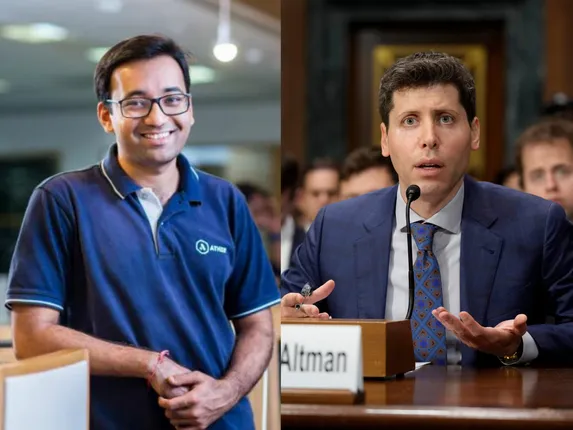OpenAI’s Expenditure Sparks Debate: Ather CEO Compares ‘Burn Rate’ to Indian Tech Giants

OpenAI’s Expenditure Sparks Debate: Ather CEO Compares ‘Burn Rate’ to Indian Tech Giants
In a recent development that has sparked a heated discussion within the tech industry, OpenAI’s daily expenditure has drawn comparisons to the well-known spending patterns of Indian tech giants like Paytm, Ola, and Flipkart. Ather Energy‘s CEO, in a candid statement, likened OpenAI’s financial ‘burn rate’ to the extravagant outflows observed in these industry giants. The comparison has stirred conversations about the cost of innovation, sustainability, and the dynamics of resource allocation.
OpenAI, a trailblazing artificial intelligence research laboratory, has been at the forefront of innovation for years, responsible for groundbreaking advancements in natural language processing, robotics, and machine learning. However, as the organization continues to push the boundaries of technology, it has also drawn attention to its substantial financial commitment, with a reported daily expenditure of Rs. 5.8 crore.
The comparison to Indian tech powerhouses comes amidst the backdrop of an ever-evolving technological landscape. Paytm, known for its pioneering mobile payment platform, has engaged in ambitious expansions that have sometimes led to significant cash outflows. Ola, a prominent ride-hailing service, and Flipkart, an e-commerce giant, have similarly demonstrated a willingness to spend extravagantly to secure their positions in the competitive market.
Ather Energy’s CEO, in drawing parallels between OpenAI’s ‘burn rate’ and that of Indian tech giants, has ignited a discourse on the trade-offs between innovation and fiscal prudence. The statement taps into the broader discussion of how companies allocate resources and whether rapid innovation comes at the cost of financial sustainability.

Critics argue that the comparison oversimplifies the complexities of each entity’s financial strategy. OpenAI’s expenditure largely contributes to groundbreaking research and development, which can lead to long-term benefits for society. In contrast, the expenditure of Indian tech giants often focuses on expanding market reach and consumer base. It’s a distinction that underscores the different priorities driving these expenditures.
The comparison also brings into focus the idea of ‘burn rate,’ a term that refers to the rate at which a company is spending its capital to cover expenses before generating positive cash flow. While Ather Energy’s CEO chose to emphasize this aspect, experts caution against viewing it in isolation. The ‘burn rate’ can be a crucial indicator of a company’s trajectory, but it should be analyzed in conjunction with other metrics like revenue growth, user acquisition, and market potential.
The underlying issue in this debate is the fundamental question of whether the pursuit of innovation should take precedence over financial stability. OpenAI’s ambitious projects, like developing advanced AI models capable of mimicking human-like language, have the potential to revolutionize industries ranging from healthcare to entertainment. Yet, these innovations require significant investments that may take years to yield returns.
In the case of Indian tech giants, the argument often centers around capturing a sizable market share in a competitive landscape. This might involve offering steep discounts, launching aggressive marketing campaigns, and expanding into new territories. While these strategies drive rapid growth, they can also lead to periods of financial strain.
The power word ‘conundrum’ aptly characterizes the dilemma faced by organizations that strive to balance innovation and fiscal responsibility. Ather Energy’s CEO’s comparison between OpenAI and Indian tech giants underscores the multifaceted nature of this conundrum. As the world becomes increasingly reliant on technological advancements, determining the optimal approach to resource allocation gains paramount importance.

In this ongoing dialogue, it’s essential to recognize that each entity, whether OpenAI or the Indian tech giants, operates within a unique ecosystem. OpenAI’s mission is to ensure that artificial general intelligence (AGI) benefits all of humanity. With this lofty goal, the organization is committed to pushing the boundaries of AI research, often requiring substantial investments in computational resources, talent acquisition, and infrastructure development. The pursuit of AGI presents a different kind of risk – the risk of not moving fast enough. As such, OpenAI’s strategy is influenced by the urgency to lead in AI capabilities and drive advancements that can have profound societal impacts.
On the other hand, Indian tech giants, while driven by innovation, are also influenced by the rapidly evolving demands of a dynamic consumer base. The hyper-competitive nature of markets often necessitates quick responses to emerging trends and technologies. For instance, Flipkart’s aggressive spending on supply chain logistics and customer acquisition is an integral part of its strategy to offer a seamless shopping experience and maintain its edge in the e-commerce arena.
The juxtaposition of these different approaches underscores the diversity of challenges and opportunities that modern businesses face. OpenAI’s focus on foundational research, which often lacks immediate commercial applications, is a high-stakes gamble aimed at paving the way for revolutionary breakthroughs. In contrast, the Indian tech giants’ investments in market growth are driven by the need to maintain relevance, capture new demographics, and sustain their competitive positions.
Moreover, the financial comparisons also shed light on the significance of risk management and strategic planning. While innovation is essential, an overly aggressive ‘burn rate’ can potentially lead to financial instability, making it harder to navigate economic downturns or unexpected challenges. On the flip side, being overly conservative might lead to missed opportunities and stagnation.

In a rapidly changing landscape, there’s no one-size-fits-all answer to the resource allocation dilemma. OpenAI’s path is guided by its vision of AI that benefits all of humanity, while Indian tech giants balance innovation with the practicalities of running successful businesses in a dynamic market. Both approaches contribute to the broader narrative of technological advancement, shaping industries and societies in unique ways.
In conclusion, the comparison drawn by Ather Energy’s CEO between OpenAI’s daily expenditure and the spending patterns of Indian tech giants is a thought-provoking entry point into the nuanced discussion of innovation, financial sustainability, and resource allocation. While the vocabulary of ‘burn rate’ might invoke notions of extravagance, the reality is far more complex.
It’s a conversation that delves into the heart of how organizations navigate the uncharted waters of technological progress, how they manage risk, and how they balance the immediate demands of the market with the long-term promise of transformative breakthroughs. As technology continues to reshape our world, the strategies employed by OpenAI and Indian tech giants will continue to shape the landscape of innovation, business, and society.




